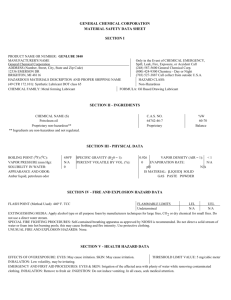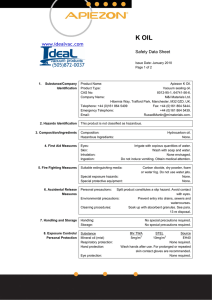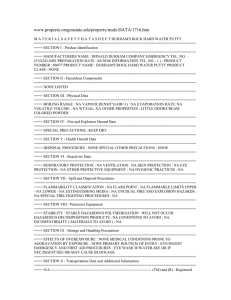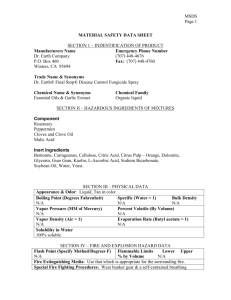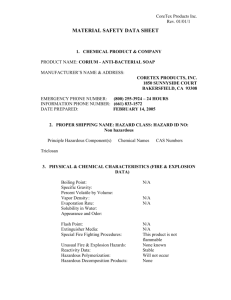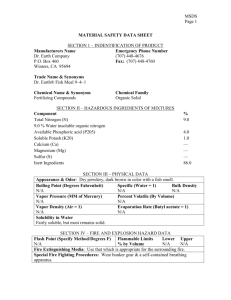Micador Colourfun Markers
advertisement
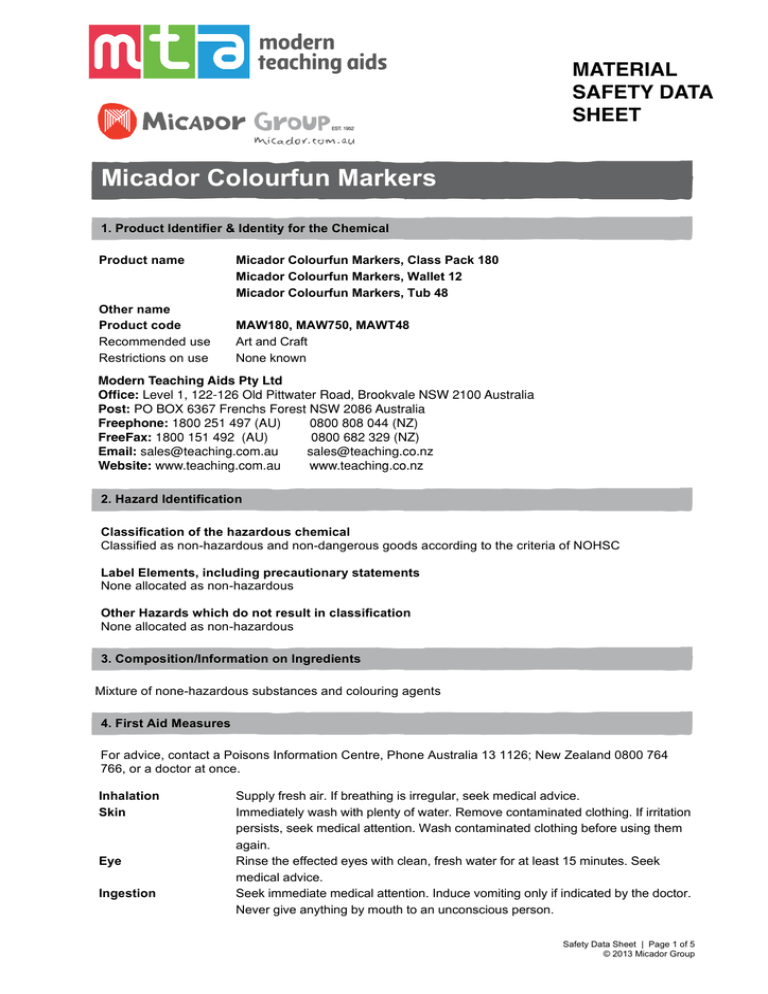
MATERIAL SAFETY DATA SHEET Micador Colourfun Markers 1. Product Identifier & Identity for the Chemical Product name Other name Product code Recommended use Restrictions on use Micador Colourfun Markers, Class Pack 180 Micador Colourfun Markers, Wallet 12 Micador Colourfun Markers, Tub 48 MAW180, MAW750, MAWT48 Art and Craft None known Modern Teaching Aids Pty Ltd Office: Level 1, 122-126 Old Pittwater Road, Brookvale NSW 2100 Australia Post: PO BOX 6367 Frenchs Forest NSW 2086 Australia Freephone: 1800 251 497 (AU) 0800 808 044 (NZ) FreeFax: 1800 151 492 (AU) 0800 682 329 (NZ) Email: sales@teaching.com.au sales@teaching.co.nz Website: www.teaching.com.au www.teaching.co.nz 2. Hazard Identification Classification of the hazardous chemical Classified as non-hazardous and non-dangerous goods according to the criteria of NOHSC Label Elements, including precautionary statements None allocated as non-hazardous Other Hazards which do not result in classification None allocated as non-hazardous 3. Composition/Information on Ingredients Mixture of none-hazardous substances and colouring agents 4. First Aid Measures For advice, contact a Poisons Information Centre, Phone Australia 13 1126; New Zealand 0800 764 766, or a doctor at once. Inhalation Skin Eye Ingestion Supply fresh air. If breathing is irregular, seek medical advice. Immediately wash with plenty of water. Remove contaminated clothing. If irritation persists, seek medical attention. Wash contaminated clothing before using them again. Rinse the effected eyes with clean, fresh water for at least 15 minutes. Seek medical advice. Seek immediate medical attention. Induce vomiting only if indicated by the doctor. Never give anything by mouth to an unconscious person. Safety Data Sheet | Page 1 of 5 © 2013 Micador Group 5. Fire Fighting Measures Suitable extinguishing media Carbon dioxide, foam, powder and nebulized water. Specific hazards arising from the chemical Hazards caused by exposure in the event of fire; do not breathe combustion products (carbon oxide, toxic pyrolysis products etc.) Special protective equipment and precautions for fire fighters GENERAL INFORAMTION Use jets of water to cool the containers to prevent product decomposition and the development of substances potentially hazardous for health. Always wear full fire prevention gear. Collect extinguishing water to prevent it from draining into the sewer system. Dispose of contaminated water used for extinction and the remains of the fire according to applicable regulations. Hardhat with visor, fireproof clothing (fireproof jacket and trousers with straps around arms, legs and waist), work gloves (fireproof, cut proof and dielectric), a depressurized mask with facemask covering the whole of the operator’s face or a self-respirator (self-protector) in the event of large quantities of fume. 6. Accidental Release Measures Personal precautions, protective equipment and emergency procedures Use breathing equipment if fumes or powders are released into the air. Environment precautions The product must not penetrate the sewers, surface water, ground water and neighboring areas. Methods and materials for containment and cleaning up Confine using earth or inert material. Collect as much material as possible and eliminate the rest using jet of water. Contaminated material should be disposed of in compliance with the provisions set forth in point 13. 7. Handling and Storage Precautions for safe handling Do not eat, drink or smoke while handling and use. Conditions for safe storage, including any incompatibilities Store in 8. Exposure Controls/Personal Protection Control parameters – exposure standards, biological monitoring NAME ROSSO 52 TRIETHANOLAMINE TYPE TLV-ACGIH TLV-ACGIH OEL TWA/8hmg/m3 10 5 5 Appropriate engineering control None known Safety Data Sheet | Page 2 of 5 © 2013 Micador Group Personal protective equipment (PPE) As the use of adequate technical equipment must always take priority over personal protection equipment, make sure that the workplace is well aired through effective local aspiration or bad air vent. HAND PROTECTION Protect hands with work gloves, such as those in latex, PVC or equivalent. SKIN PROTECTION Wear professional long sleeve overalls and safety footwear. Wash body with soap and water after removing overalls. RESPIRATORY PROTECTION The use of breathing protection equipment, such as masks with organic vapor and dust/mist cartridges, is necessary in the absence of technical measures limiting worker exposure. EYE PROTECTION Use of protective airtight goggles recommended 9. Physical and Chemical Properties Appearance Ink is of liquid form Odour Imperceptible Odour threshold None known pH 7-9 Melting point/freezing point None known Boiling point and boiling range None known Flash point None known Evaporation rate None known Flammability None known Upper/lower flammability or explosive limits NNone known Vapour pressure None known Vapour density None known Relative density None known Solubility (ies) Soluble in water Partition coefficient: n-octanol/water None known Auto-ignition temperature None known Decomposition temperature None known Viscosity 2,54 +/- 0.24 cSt Specific heat value None known Particle size None known Volatile organic compounds content None known % volatile None known Saturated vapour concentration None known None known Release of invisible flammable vapours and gases Additional parameters Shape and aspect ratio Crystallinity Dustiness Surface area Degree of aggregation or agglomeration Ionisation (redox potential) Biodurability or biopersistence None known None known None known None known None known None known None known Safety Data Sheet | Page 3 of 5 © 2013 Micador Group 10. Stability and reactivity Reactivity Chemical stability Conditions to avoid Incompatible materials and possible hazardous reactions Hazardous decomposition products Stable under normal conditions of storage and use POLYETHYLENGLYCOL: decomposes slowly at high temperatures in the presence of air. The product is table in normal conditions of use and storage None in particular, however the usual precautions used for chemical product should be respected POLYETHYLENGYCOL: avoid contact with oxidising agents and concentrated inorganic acids No hazardous reactions are foreseeable in normal conditions of use and storage None known 11. Toxicological information According to current available data, this product has not yet produced health related damages. Anyway, it must be handled carefully according to good industrial practices. This product may have slight health effects on sensitive people, by inhalation and/or cutaneous absorption and/or contact with eyes and/or ingestion. Potential adverse health effects and symptoms associated with exposure to the material Acute health effect Swallowed Eyes Skin Inhaled Irritating effect possible Irritating effect possible Irritating effect possible Irritating effect possible 12. Ecological information Ecotoxicology Persistence and degradability Bioaccumulative potential Mobility in soil Other adverse effects None Known None Known None Known None Known None POLYETHYLENGLYCOL LC50 (96h): >100 mg/l Leuciscus idus ACCESS BLUE 96 EC50 (48h): >707 mg/l CERIODAPHNIA DUBIA TRIETHYLENEGLYCOL LC50 (96h): >1000mg/l LEPOMIS MACHOCHIRUS EC50 (48h): >10000mg/l DAPHNIA MAGNA Use this product according to good working practices. Avoid littering. Inform authorities should the product reach waterways or sewers or contaminate soil or vegetation. Safety Data Sheet | Page 4 of 5 © 2013 Micador Group 13. Disposal considerations Safe handling and disposal methods Disposal of any contaminated packaging Environmental regulations Reuse, when possible. Disposal must be made according to authorized waste management firm, in compliance with local, state and federal regulations. Contaminated packaging must be recovered or disposed of in compliance with national waste management regulations None Known 14. Transport information UN number Proper shipping name Transport hazard class(es) Packing group Environmental hazard Special precautions during transport Hazchem code None Known None Known None Known None Known None Known None Known None Known 15. Regulatory information Safety, health environmental regulations specific for the product in question None Known Poisons schedule number None Known 16. Other information Date of preparation or review Key abbreviation or acronyms used Revision number Name of version that this document supersedes 07 August, 2013 None Known None Known None Known Prepared By: Lee Du Safety Data Sheet | Page 5 of 5 © 2013 Micador Group
